
Eucalyptus platypus, also known as moort or maalok, is a species of mallee or marlock that is endemic to the southwest of Western Australia. It has smooth bark, broadly elliptical to more or less round adult leaves, flower buds in groups of nine on a broad, flattened peduncle, usually creamy white flowers and conical, down-turned fruit.

Xanthosia is a genus of flowering plants in the family Apiaceae and is endemic to Australia. It comprises 20 species of shrubs endemic to Australia. Plants in the genus Xanthosia are perennial herbs or small shrubs, the leaves divided, toothed or lobed,, the flowers white, pinkish or pale green and usually arranged in a compound umbel.
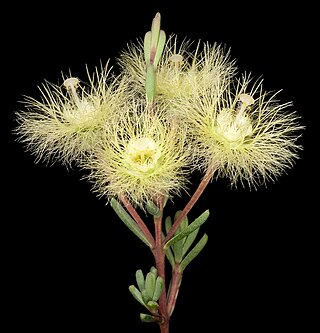
Verticordia huegelii, commonly known as variegated featherflower, is a flowering plant in the myrtle family, Myrtaceae and is endemic to the south-west of Western Australia. It is a sometimes an erect shrub, sometimes sprawling to almost prostrate. It has linear leaves and very feathery flowers in spring. The flowers are usually cream-coloured or white, becoming pinkish and reddish or maroon as the flowers age, giving a variegated appearance to the display.

Grevillea umbellulata is species of flowering plant in the family Proteaceae and is endemic to the south-west of Western Australia. It is a spreading shrub that forms a lignotuber, has linear to narrowly elliptic leaves, and cylindrical clusters of hairy, white to cream-coloured flowers often tinged with grey or pink.
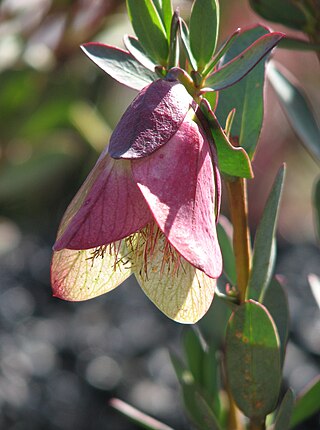
Pimelea physodes, commonly known as Qualup bell, is a species of shrub that is endemic to Western Australia. It has egg-shaped to narrow elliptical leaves and distinctive bell-like inflorescences with tiny greenish flowers surrounded by long elliptical bracts. The inflorescence resembles those of some of the only distantly-related darwinia "bells" and the bracts are a combination of red, purple, green and cream-coloured.
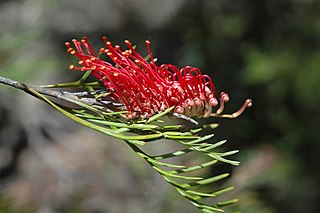
Grevillea hookeriana, commonly known as red toothbrushes or Hooker's grevillea, is a species of flowering plant in the family Proteaceae and is endemic to the south-west of Western Australia. It is a spreading to erect shrub, usually with linear leaves or deeply divided leaves with linear lobes, and toothbrush-shaped groups of red, black or yellowish green flowers, the style maroon to black.
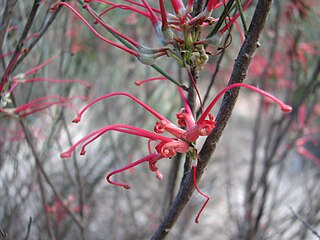
Grevillea sarissa, commonly known as wheel grevillea, is a species of flowering plant in the family Proteaceae and is native to South Australia and Western Australia. It is a spreading shrub, usually with linear leaves, and more or less erect, wheel-like to more or less spherical clusters of red or yellow flowers.

Grevillea acrobotrya is a species of flowering plant in the family Proteaceae and is endemic to the southwest of Western Australia. It is a prickly, spreading to erect shrub with egg-shaped to trowel-shaped leaves with sharply-tipped lobes, and white to cream-coloured flowers with smaller leaves at the base.
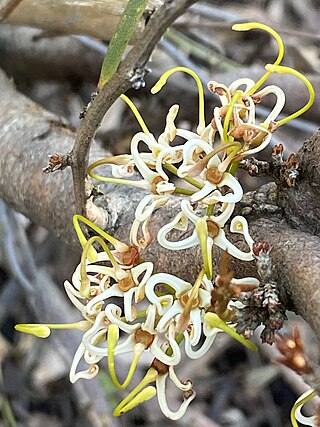
Hakea platysperma, commonly known as the cricket ball hakea, is a shrub in the family Proteaceae. It has long, sharply pointed, needle-shaped leaves and fragrant cream-reddish flowers in clusters from July to October. It is endemic to the south west of Western Australia.
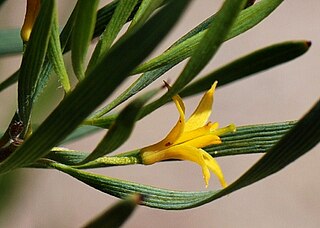
Persoonia quinquenervis is a species of flowering plant in the family Proteaceae and is endemic to the south-west of Western Australia. It is an erect, spreading shrub with hairy young branchlets, twisted linear, lance-shaped, narrow oblong or narrow spatula-shaped leaves, and bright yellow flowers borne in groups of up to ten on a rachis up to 60 mm (2.4 in) that continues to grow after flowering.
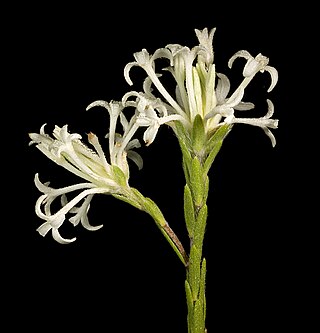
Pimelea longiflora is a species of flowering plant in the family Thymelaeaceae and is endemic to the southwest of Western Australia. It is an erect, spindly shrub with linear to narrowly elliptic leaves and erect clusters of white to cream-coloured flowers, surrounded by 4 to 6 green, egg-shaped involucral bracts.

Grevillea coccinea is a species of flowering plant in the family Proteaceae and is endemic to the south of Western Australia. It is a low-lying or sprawling shrub with narrowly wedge-shaped to linear leaves and white, cream-coloured, and red or yellow flowers.

Grevillea shuttleworthiana is a species of flowering plant in the family Proteaceae and is endemic to the south-west of Western Australia. It is a more or less erect shrub with variably-shaped leaves, the shape depending on subspecies, and cylindrical clusters of cream-coloured to yellow or greenish flowers, often held above the foliage.

Grevillea velutinella is species of flowering plant in the family Proteaceae and is endemic to northern Western Australia. It is a shrub with broadly egg-shaped leaves in outline, sometimes with 2 to 7 teeth, and down-turned, often branched clusters of yellowish-green to lemon or cream-coloured flowers.
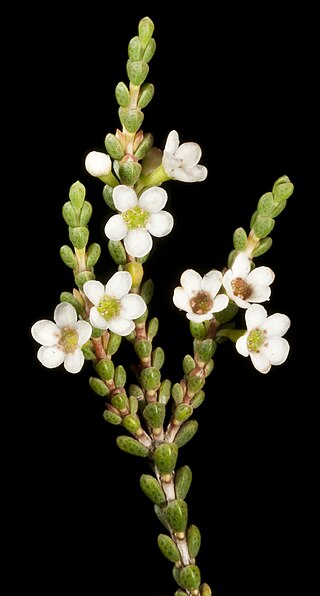
Micromyrtus erichsenii is a species of the family Myrtaceae and is endemic to Western Australia. It is an erect shrub with small, egg-shaped leaves with the narrower end towards the base, and white or cream-coloured flowers 3–4 mm (0.12–0.16 in) in diameter and 5 to 10 stamens.
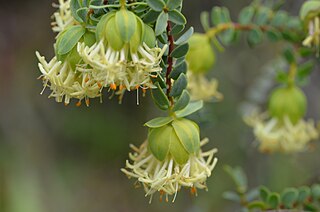
Pimelea sulphurea, commonly known as yellow banjine, is a species of flowering plant in the family Thymelaeaceae and is endemic to the south-west of Western Australia. It is an erect, spindly or open shrub with narrowly elliptic to more or less round leaves, and compact heads of pendulous, yellow flowers surrounded by 3 or more pairs of green to yellowish involucral bracts.

Asterolasia grandiflora is a species of weak, open shrub or sub-shrub that is endemic to the southwest of Western Australia. It has oblong, elliptical or egg-shaped leaves and pink to mauve flowers arranged in umbels of about three flowers with a thick covering of star-shaped hairs on the back of the petals.
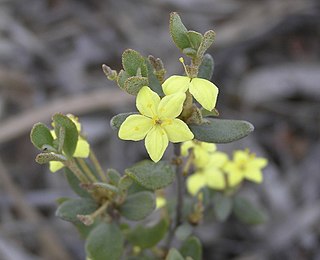
Asterolasia squamuligera, commonly known as yellow starbush, is a species of erect, woody, slender perennial shrub that is endemic to the southwest of Western Australia. It has leathery, egg-shaped leaves with the narrower end towards the base and yellow flowers arranged in umbels of five to ten with a fringe of scales on the back of the petals, and about ten stamens.

Xanthosia candida is a low-lying, perennial herb in the family Apiaceae and is endemic to the south-west of Western Australia. It has long, slender stems, irregularly toothed or lobed leaves and small white, green or creamy-yellow flowers.
Xanthosia dissecta is a species of flowering plant in the family Apiaceae and is endemic to south-eastern Australia. It is a prostrate, tufted herb with dissected leaves at the base of the plant, and small white or reddish flowers arranged in one or two umbellules, each with up to 3 flowers.



















